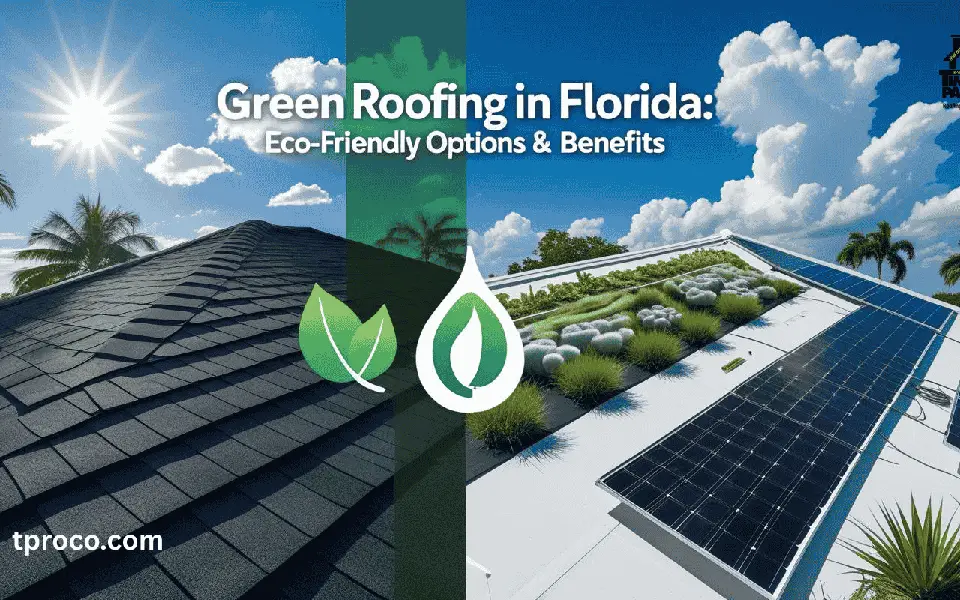Our Blogs
Roof Ventilation Options for Florida: Keep Your Roof Cool & Dry 🌬️
A roof without proper ventilation is like a pressure cooker—the heat trapped in your attic can warp shingles, promote mold growth, and lead to premature roof failure. In Florida’s tropical climate, where humidity and high temperatures are year-round, effective roof ventilation is critical to extending the life of your roof and improving your home’s energy efficiency. In this blog, we’ll examine the different types of roof vents you can use to ensure your attic breathes properly, from ridge vents and soffit vents to power fans and solar-powered options. Understanding these systems allows you to make the best choice for your Florida home’s roof and interior comfort.

Importance of Roof Ventilation in Florida’s Climate
In Florida, roofs face a unique set of challenges due to the state's intense sunlight and frequent rain. Without proper ventilation, these challenges can lead to:
Heat Buildup:
The attic is the first part of your roof to feel the heat from the sun. As it traps this heat, the internal temperature can reach unbearable levels, which accelerates the deterioration of shingles and causes energy bills to spike.
Moisture Accumulation:
Florida’s high humidity can cause moisture to build up in attics, especially when there’s little airflow. This trapped moisture can lead to mold growth, mildew, and rot in the roof structure and insulation.
Ice Damming (in rare conditions):
Although this is a more northern issue, Florida’s brief cold snaps can still contribute to condensation and wetness in poorly ventilated attics, which damages roofing materials over time.
Proper roof ventilation ensures that hot air and moisture escape, preventing damage to the roof deck, shingles, and insulation. It keeps your roof in optimal condition by maintaining a healthy environment in the attic, which is crucial for Florida’s hot and humid climate. Whether you have a simple gable roof or a complex hip roof, proper airflow can save you money in the long run by extending your roof's lifespan and reducing your cooling costs.
Types of Roof Vents for Florida Homes
There are several types of roof ventilation options, each with its own benefits and installation requirements. The most common types used in Florida include:
Ridge Vents:
These are installed along the peak of the roof, allowing hot air to escape from the attic naturally. Ridge vents work with soffit vents to create a continuous flow of air. They are one of the most efficient options for Florida homes, providing passive ventilation without requiring electrical power. Ridge vents are also very low-profile, making them a great choice for homeowners concerned about aesthetics.
Soffit Vents:
Installed under the eaves of your roof, soffit vents provide the intake ventilation needed to draw air into the attic. When combined with ridge vents, soffit vents allow for effective cross-ventilation that helps regulate temperature and moisture levels in the attic. These vents are especially useful for preventing heat buildup in Florida’s sweltering summers.
Gable Vents:
Located at the gable ends of the roof, these vents allow air to flow in and out of the attic. Gable vents can work well for attics with little roof slope, but they are less efficient than ridge and soffit vent combinations, as they do not create a continuous airflow pattern.
Power Attic Fans:
These electric fans are mounted in the roof to help expel hot air from the attic. While they can be very effective, they tend to increase energy consumption. In Florida, where electricity costs can be high, they are not always the most cost-effective option. Solar-powered attic fans are an eco-friendly alternative, requiring no electricity and harnessing Florida’s abundant sunlight to run the fan efficiently.
Choosing the right combination of vents depends on the structure of your roof, attic space, and budget. Ridge and soffit vents are often the most efficient for residential homes, but if your home has a low-pitched roof or you’re facing extreme heat issues, power fans may provide additional benefits. In Florida’s heat, ventilation is key to keeping your attic cool, dry, and free from moisture damage.
Installing & Maintaining Roof Ventilation Systems
Proper installation and regular maintenance of your roof ventilation system are essential to ensure it functions optimally in Florida’s climate:
Professional Installation:
While some roof vents can be installed by homeowners, it is often best to hire a professional to install ridge vents, soffit vents, or power attic fans. A roofer or contractor will ensure that the vents are positioned correctly, sealed properly, and comply with Florida’s building codes. Poor installation can lead to leaks or inefficiencies in airflow.
Inspect Regularly:
Inspect your roof vents at least once a year. Check for obstructions, such as leaves or debris, that can block airflow. In Florida, the frequent rains and storms can cause debris to accumulate in vents, so cleaning them out regularly will help maintain proper airflow.
Check for Sealant Integrity:
Ensure that the flashing around the vents is intact and that no sealant has cracked or deteriorated. Water intrusion at the vents can lead to leaks and mold growth. Resealing flashing every few years can prevent this issue from developing.
Upgrade as Needed:
If your home’s attic temperature or humidity levels remain high despite proper ventilation, consider upgrading to more efficient vents. Solar-powered attic fans or additional soffit vents can improve air circulation in stubborn spaces.
Regular maintenance and timely repairs will help keep your attic cool, dry, and ventilated, reducing energy costs and preventing long-term damage to your roof. In Florida’s intense heat and humidity, making the right ventilation decisions and maintaining your system can extend the life of your roof and increase your home’s energy efficiency.
Ventilation and Energy Savings: Lowering Cooling Costs
Attic ventilation is one of the easiest ways to reduce your cooling bills in Florida. When your attic is properly ventilated, it remains cooler, which reduces the amount of heat that enters your home. Without proper ventilation, your attic can reach temperatures upwards of 150°F, making your air conditioning system work overtime to cool the rest of your home. This leads to higher energy bills.
By ensuring your attic has the right number of soffit and ridge vents, you can lower your cooling costs by as much as 10-15% per year. The air circulation helps keep temperatures consistent throughout your home, reducing the strain on your HVAC system. Additionally, some roofers offer reflective coatings and underlayment that reflect sunlight away from your home, further improving energy efficiency. Whether you’re re-roofing or upgrading your current system, choosing energy-efficient materials and ventilation systems is a smart move for Florida homeowners.
Choosing the Right Roof Ventilation for Your Florida Home
When deciding on roof ventilation for your Florida home, consider the following factors:
- Roof Pitch & Size: Steeply pitched roofs benefit from ridge and soffit vents, while low-pitched roofs may require additional fans or gable vents to maintain airflow.
- Climate Zones: Coastal homes need vents that can handle humidity and salty air. Metal or plastic vents with rust-resistant coatings are ideal in these areas.
- Budget: Ridge and soffit vents are the most cost-effective option for most homes. Solar-powered attic fans cost more but can be more energy-efficient in the long run.
Each home is unique, so consulting with a professional roofer will help you decide on the best combination of roof vents to keep your home cool, dry, and energy-efficient, no matter the season.
Conclusion
🌡️ Proper attic ventilation is an often-overlooked but critical part of maintaining your Florida home. By installing and maintaining ridge vents, soffit vents, and other ventilation systems, you protect your roof from damage, increase your home’s energy efficiency, and prevent costly mold growth. Regular inspection, cleaning, and upgrades as needed ensure that your attic remains well-ventilated, even during the hottest and most humid Florida months. Whether you choose passive or active ventilation, the investment in a proper system pays off in the form of lower cooling costs, longer roof life, and a more comfortable home for your family.
Frequently Asked Questions (FAQ)
🌬️ Keep Your Florida Roof Cool, Dry & Long-Lasting!
Overheating attic? Learn how ridge vents, soffit vents, and fans can reduce moisture, cut energy bills, and extend your roof’s life in Florida’s climate.
#tproco #tppro #tprci #urro #rrfl
#RoofVentilation #FloridaEnergySavings #AtticCooling #TampaHomes #OrlandoVentilation #SunshineState
Schedule a Free InspectionAbout the Author

Timothy Parks
CEO
📢 Stay Informed: Communication & Consent Updates
At Timothy Parks Roofing & Construction Inc., we prioritize transparency in our communications. By submitting a request, you agree to receive calls, texts, and emails regarding our services. Standard messaging rates may apply. You can opt-out at any time by replying STOP or contacting us directly.
✅ Florida License: #CBCO59592, #CCC1327217, #HI4878
📌 Privacy & Terms: Read our Privacy Policy and Terms of Service.



